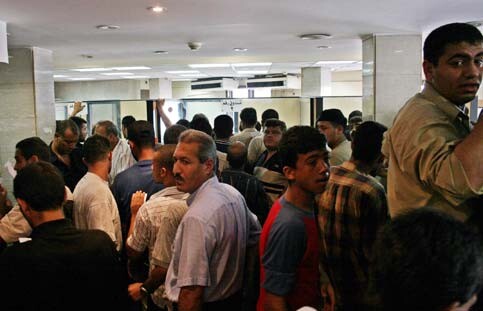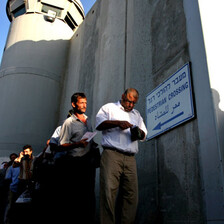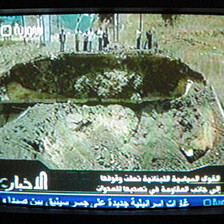Palestine Center 5 November 2006

Palestinian government employees demonstrate inside the Arab Bank in Gaza demanding their salaries. The Palestinian Authority made a 1500 NIS deposit for all of its employees, but several banks decided to keep 30 % of the amount to cover accumulated debts, August 19, 2006. (MaanImages/Wesam Saleh)
Overview: When Israel launched its demographic war against Palestinians in 1947, it was carried out through military tactics that were difficult to conceal from the international community. The unresolved result of that war can be seen in refugee camps all over the Arab world. According to U.N. figures, between 1947 and 1949 Zionist military forces forcibly expelled or caused to flee approximately 800,000 Palestinians (amounting to 75 percent of the Arab population of what became Israel). In 1967, more than 200,000 Palestinians fled their homes in the West Bank and Gaza Strip during Israel’s offensive against Jordan and Egypt and the subsequent occupation of the West Bank, East Jerusalem and the Gaza Strip. Since 1967, Israel has continued its demographic war but the tactics have become obscured through the use of so-called legal and political criteria.
A recent tactic, which U.S. Secretary of State Condoleezza Rice promised to personally address, is Israel’s denial of entry/reentry of Palestinian Americans into the Occupied Palestinian Territory. However, for decades, Israel has carried out a “quiet transfer” in the form of restrictions on and rejection of family reunification applications. Another tactic which involves the international community as well as Israel is the economic embargo. During a press conference in Ramallah, Palestinian Deputy Foreign Minister Ahmed Subuh revealed that hundreds of thousands of Palestinians have applied for immigration visas at various foreign consulates operating in the Palestinian areas in an attempt to escape the crippling international economic sanctions that have been placed on Palestinians since the election of Hamas.
Family Reunification and Residency
In 1967, Israel carried out a population census in the West Bank and Gaza Strip. Palestinians present at the time were entered in the population registry and given residency. Anyone over sixteen was issued an identity card and those under sixteen were listed with their parents. Since then and despite the authority relating to family reunification and visitor’s permits being transferred to the Palestinian Authority (PA) under the Oslo Accords, real power has remained in Israel’s hands.
Israel has maintained control over the population registry of the Occupied Territory and only registered persons are allowed entry unless Israel grants a visitor’s visa. Through an “immediate relative,” non-registered persons can submit an application for family reunification which is then put through a rigid checks system with no clear or set rules. In addition to denied requests for family reunification, the PA’s Committee for Civil Liaison reported that between 1967 and 1995 Israel revoked the residency of approximately 100,000 Palestinians who lived outside the Occupied Territory for more than six consecutive years.
In theory, Palestinians not registered in the population registry can apply for residency through the family reunification process. Israel argues that family reunification is not, as stated in the 1992 response of the State Attorney’s Office in the case of Sarhan et al.v. Commander of IDF Forces in Judea and Samaria et al, a vested right, but a “special benevolent act of the Israeli authorities.” The majority of family reunification applications are from families who are unable to live together in the Occupied Palestinian Territory because one of the spouses is not a resident.
According to the Israeli human rights group B’tselem, between 1967 and 1972, Israel approved 45,000 - 50,000 of the 140,000 family reunification applications. However, not one application for males between the age of sixteen and 60 was approved. In 1973, Israel issued new criteria for the application process which was labeled confidential and remained in effect until 1982. According to Israeli historian Meron Benvenisti, Israel approved 1,000 applications per year during this period. He found that in the early 1980s some 15,000 applications were not addressed.
From 1983 to 1992, Israel again changed the criteria and only considered applications on a humanitarian basis. In 1987, an Israeli military order barred the registration of children whose mothers were non-residents, further fracturing the family unit. Although the order was canceled in 1995, the Israeli Civil Administration ignored the change and in August 1993, a month before the White House signing of the Declaration of Principles, Israel set a quota of 2,000 family reunification requests a year. From November 1995 to August 1996, Israel froze all reunification requests and then in 1998, Israel increased the quota to 3,000 applications per year and to 4,000 in 2000. Since September 2000, Israel has placed a freeze on all applications.
Emigration from the Occupied Territory
According to the Palestinian foreign ministry, between June and October 2006, foreign consulates operating in the Palestinian territory received 10,000 immigration applications raising the total of immigration applications before the various consulates to 45,000. During a 1 November 2006 press conference Subuh attributed the high volume of applications to Israel’s policies of incursions, settlement expansion and the construction of a separation wall, the isolation of Jerusalem and other economic centers in the West Bank, the international economic embargo and internal Palestinian strife. According to Subuh, the majority of those seeking to leave are professionals who are employed by the PA.
In addition to “locals” wanting to emigrate, Subuh pointed out that Israel’s policy of denying Palestinians with foreign passports-mainly Palestinian Americans-from returning has hurt the private sector at the business and education levels. The policy has also hurt humanitarian relief efforts in the Occupied Palestinian Territory. According to Subuh, personnel of various U.N. agencies are no longer allowed to extend their permits in order to continue their work. Although the ministry does not have past emigration numbers for comparison, Subuh expressed grave concern over the current emigration trends.
In addition to Israel’s policy of denial of entry/reentry, decades of restrictions, rejection and freeze on family reunification applications, home demolitions and land confiscation for settlement expansion and the construction of the separation wall, one major factor pushing Palestinians to leave is the economic embargo.
The Economic Factor
According to a 1 November 2006 International Monetary Fund (IMF) report, there has been a 60 percent drop in Palestinian income since Hamas took power in March 2006. The IMF report found that from April to September 2006, the PA coffers took in $500 million compared to $1.5 billion during the same period in 2005. The IMF stated that a main factor for the decrease was Israel’s failure to transfer $360 million in tax revenues it owed the PA.
Interestingly, despite the economic embargo imposed on the PA since Hamas came to power, the government received $420 million in foreign aid between April and September 2006, which, according to the IMF surpassed the amount received during 2005. The majority of the funds, $300 million, came from Arab countries but bypassed the Hamas government. According to the IMF, of the $300 million, $246 went directly to the president’s office.
According to the IMF report, 80 percent of the $500 million was used to cover the salaries of government employees and pay utility bills leaving a small sum for other budgetary needs. Despite the difficulty in securing salaries, the IMF reported that the PA added approximately 5,400 employees to its payroll in 2006, the majority being employed in the security sector. An additional 20,000 security officers are in training and may be added to the payroll in the future. Currently, the government payroll stands at $100 million per month compared to $80 million in mid 2005.
The Right to Family Life
Despite the economic hardship, the most difficult issue facing Palestinians is the ability to reunite with their families. According to B’tselem, as of October 2005, 72,000 Palestinian families in the Occupied Palestinian Territory have submitted a family reunification application for an immediate family member living abroad or living in the territory but considered by Israel to be an illegal resident.
Article 16 of the Universal Declaration of Human Rights states: “Men and women of full age, without any limitation due to race, nationality or religion, have the right to marry and to found a family. They are entitled to equal rights as to marriage and its dissolution.” It further states: “The family is the natural and fundamental group unit of society and is entitled to protection by society and the State.”
The International Covenant on Civil and Political Rights of 1966 which Israel ratified in 1991, states: “The right of men and women of marriageable age to marry and to found a family shall be recognized.” B’tselem argues that Israel, as an occupying power, has an obligation to secure the right of Palestinian residents to have their children and spouses obtain residency so that they can live together.
While Palestinians face a quiet transfer from their land, B’tselem has documented a significant increase in Jewish residents in Israel and of settlers in the West Bank. Between 1997 and 2004 there was an 11.4 percent growth among Jewish residents in Israel and a 52.8 percent growth among Jewish settlers in the West Bank.
Samar Assad is the Executive Director of The Palestine Center. This is Palestine Center Information Brief No. 144, and was published on 3 November 2006. The Palestine Center is an independent think-tank committed to communicating reliable and objective information about the Palestinian political experience to American policy makers, journalists, students and the general public. Established in 1991, it is the educational program of the Jerusalem Fund for Education and Community Development. This information brief does not necessarily reflect the views of The Jerusalem Fund.
Related Links


